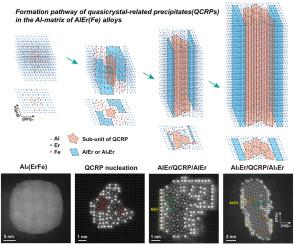Nucleation and growth of quasicrystal-related precipitates within the Al-matrix of AlEr(Fe) alloys
IF 8.2
2区 材料科学
Q1 MATERIALS SCIENCE, MULTIDISCIPLINARY
引用次数: 0
Abstract
Since the discovery of quasicrystals, their applications to industry have been interesting issues, among which attempts of introducing quasicrystal-related precipitates into the Al-matrix to enhance properties of Al alloys have been made without adequate understandings. Here, we report a formation pathway of quasicrystal-related precipitates in the Al-matrix of an AlEr(Fe) alloy. It is shown that upon thermal aging of the alloy, Al3Er precipitates form firstly in the Al-matrix, then quasicrystal-related (AlFe)-precipitates may nucleate heterogeneously within the Al3Er precipitates and grow large. As the quasicrystal-related precipitate grows large, the Al3Er-precipitate reform as the thin “skin” of the formed composite precipitate, keeping the quasicrystal-related portion well separated from the matrix. Atomic-resolution electron microscopy and spectroscopy reveal that these composite precipitates are the mixtures of the Al13Fe4 quasicrystal approximant structure and/or quasicrystal-related aperiodic structures, as well as their surrounding skin with Al3Er-structure. As such, Fe atoms as vexing impurity in Al alloys can be absorbed continuously into such composite precipitates. Our findings provide insights into the feasibility to form quasicrystal-related precipitates in the Al-matrix.

AlEr(Fe) 合金的铝基体中准晶体相关沉淀的成核与生长
自发现准晶体以来,其在工业中的应用一直是令人关注的问题,其中在铝基体中引入准晶体相关析出物以提高铝合金性能的尝试一直没有得到充分的理解。在此,我们报告了 AlEr(Fe)合金的铝基体中准晶相关析出物的形成途径。研究表明,合金热老化后,首先在铝基体中形成 Al3Er 沉淀,然后准晶相关(AlFe)沉淀可能在 Al3Er 沉淀中异质成核并逐渐增大。随着准晶相关沉淀的增大,Al3Er-沉淀会重新形成复合沉淀的薄 "表皮",从而使准晶相关部分与基体保持良好的分离。原子分辨率电子显微镜和光谱分析显示,这些复合沉淀物是 Al13Fe4 准晶近似结构和/或准晶相关非周期性结构的混合物,以及其周围带有 Al3Er 结构的表皮。因此,铝合金中令人头疼的杂质铁原子可以被不断吸收到这种复合沉淀物中。我们的研究结果为在铝基体中形成准晶体相关沉淀物的可行性提供了启示。
本文章由计算机程序翻译,如有差异,请以英文原文为准。
求助全文
约1分钟内获得全文
求助全文
来源期刊

Materials Today Nano
Multiple-
CiteScore
11.30
自引率
3.90%
发文量
130
审稿时长
31 days
期刊介绍:
Materials Today Nano is a multidisciplinary journal dedicated to nanoscience and nanotechnology. The journal aims to showcase the latest advances in nanoscience and provide a platform for discussing new concepts and applications. With rigorous peer review, rapid decisions, and high visibility, Materials Today Nano offers authors the opportunity to publish comprehensive articles, short communications, and reviews on a wide range of topics in nanoscience. The editors welcome comprehensive articles, short communications and reviews on topics including but not limited to:
Nanoscale synthesis and assembly
Nanoscale characterization
Nanoscale fabrication
Nanoelectronics and molecular electronics
Nanomedicine
Nanomechanics
Nanosensors
Nanophotonics
Nanocomposites
 求助内容:
求助内容: 应助结果提醒方式:
应助结果提醒方式:


